OH MERCY
Bob Dylan’s 1989 album On Mercy represented a crucial turning point in his career. The ‘post-gospel’ records he had put out in the 1980s had received poor reviews. Most critics and fans agreed that Shot of Love (1981), Infidels (1983) and Empire Burlesque (1985), despite including some brilliant songs, were patchy affairs. By the time of Knocked out Loaded (1986) and Down in the Groove (1988), he did not even seem to have enough new material to fill his albums. His tongue in cheek contributions to the lively ’super group’ project The Traveling Wilburys (1988) were entertaining, although they offered little intellectual or emotional depth. A new approach was clearly needed. He thus agreed to work with eclectic Canadian producer and musician Daniel Lanois, renowned for his highly distinctive work on U2’s The Joshua Tree (co-produced with Brian Eno). For the first time, the recording of Dylan’s songs was being managed by an ‘authorial’ producer. Lanois, working with Dylan in his home studio in New Orleans, duly fashioned a shimmering and hypnotic soundscape, making the tracks sound mysterious and beguiling. The release of the album subsequently did much to restore Dylan’s critical reputation.
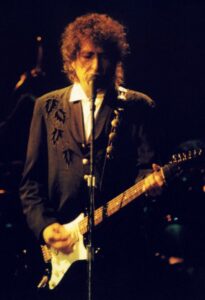
OH MERCY AND BLOOD ON THE TRACKS
Oh Mercy has often been compared to 1975’s album Blood on the Tracks. Both have a distinctive unity of style, sound and themes and both could be labeled ‘comeback’ albums. However, while the earlier work had a complex linguistic approach and richly metaphorical and allusive lyrics, in Oh Mercy such poetic techniques are kept to a minimum. Dylan sticks mainly to direct language and simple rhyming couplets. Whether he is expressing his own real feelings or projecting them through invented characters, he comes across as rather guarded and restrained. Beneath the surface of these self effacing songs, he seems to be struggling to give vent to the musical and lyrical power he has projected in the past. Yet this tone of restraint itself makes Oh Mercy a unique and distinctive addition to his oeuvre. Most critics rated it as his most consistent and effective album of the decade, although Dylan himself (always suspicious of the use of studio ‘trickery’) was somewhat ambivalent about the results.
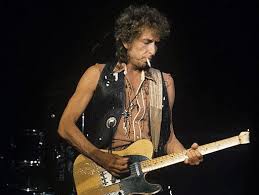
In three ‘love songs’ from the album, Dylan’s narrators address his lovers with a mixture of irony, regret and bitterness. We can sense great heartbreak behind the sleek surfaces of the songs, but this is never explicitly spelled out. In Most of the Time the narrator puts on a brave face, while claiming to be coping with the breakdown of a relationship. In What Was it You Wanted and What Good Am I the narrators sound highly uncertain of themselves. All are suitable for ‘soulful’ treatments, as demonstrated by Bette Lavette’s compelling take on Most of the Time, Solomon Burke’s and Tom Jones’ deeply affecting versions of What Good Am I and Willie Nelson’s quietly reflective and highly atmospheric What Was it You Wanted. These thoughtful and expressive covers demonstrate why Dylan was not entirely satisfied with Lanois’ work on the album, despite its highly distinctive approach. Yet perhaps it is Dylan himself, realising how crucial these songs will be in rebuilding his reputation, who is holding himself back.#

Although the settings of Oh Mercy are brilliantly structured by Lanois, allowing and quite possibly inspiring Dylan prove that he has still ‘got it’, the songs themselves can certainly stand alone outside the atmospheric musical language of the album. An earlier version of Most of the Time, which appears on the Bootleg Series release Tell Tale Signs, is performed with just acoustic guitar and harmonica and is delivered at a faster pace than the album version. The song was also rerecorded during the Under the Red Sky sessions in 1990 in a fairly straightforward rock mode. This became the model for Dylan’s forty live performances of the song between 1989 and 1992. What Was it You Wanted, which was played 22 times between 1989 and 1995, was also transformed into an energetic rock workout. The song was revived for the ‘pandemic show’ Shadow Kingdom in 2001, in a slow and thoughtful reading that was closer to the original. What Good Am I has had a much more extensive performing life, having been played around 200 times up to 2014. Dylan experimented with various styles in presenting the song.

DANIEL LANOIS
Most of the Time is a consistent exercise in heavily emphasised irony. The title phrase is used fourteen times and appears at the beginning and end of all four verses. Dylan’s mournful, embittered vocal contrasts with apparently positive lyrics. Lanois’ own bass leads the recording, providing a slow throbbing pulse with occasional ‘drop outs’ that mirror the narrator sometimes missing a heartbeat as he attempts to rise above his troubles. We are taken deeper and deeper into his inner feelings, which are as despairing at the end of the song as at the beginning. Each of the verses begins with four short lines, with the title phrase repeated in lines one and three. The second and fourth lines consist of rather unconvincing claims of the narrator’s supposed ability to cope with his lover having rejected him. He asserts that …I’m clear focused all around/ I can keep both feet on the ground… Later we are told …My head is on straight/ I’m strong enough not to hate… He contends that he is quite sanguine about the situation: …It’s well understood/ I wouldn’t change it if I could… although in the final verse he begins to equivocate: …I’m halfway content/ I know exactly where it went… Each line is preceded by the repeated title phrase, which immediately undercuts the supposedly self assured statements.
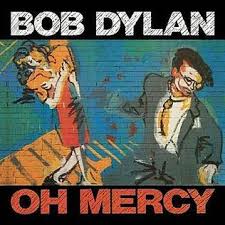
Throughout the song the narrator struggles to maintain his dignity. We soon sense that he knows that his pronouncements are hollow – and that we can see them. The second sections of the verses maintain the plain speak in which the song is written, with some slight metaphorical connotations in the first verse, as Dylan sings …I can follow the path, I can read the signs/ Stay right with it when the road unwinds/ I can handle whatever I stumble upon/ I don’t even notice she’s gone….. But these supposedly self confident statements are always undercut by the repetition of the title phrase. It is as if the narrator is trying desperately to build up his own confidence, but keeps finding himself being held back. At the end of each verse he attempts to convince us (and, more pertinently, perhaps, himself) that he is no longer emotionally invested in the lover. We surely do not believe these pronouncements, which continue with …I don’t even think about her…, …I don’t even remember what her lips felt like on mine… and …I don’t even care if I see her again… If he really feels like this, we must ask ourselves, why does he sound so distraught?

We are given further desperate attempts at justification: … I can make it all match up, I can hold my own/ I can deal with the situation right down to the bone/
I can survive, I can endure… is followed by …I don’t build up illusion ’til it makes me sick/
I ain’t afraid of confusion no matter how thick/ I can smile in the face of mankind… and
… I don’t cheat on myself, I don’t run and hide/ Hide from the feelings that are buried inside/
I don’t compromise and I don’t pretend… Of course, we know by now that he is pretending, he is certainly ‘building up illusion’, and he is not really fully capable of ‘dealing with the situation’. The song also has a short bridge section between the third and fourth verses, which begins by reasserting the same message but then descends into uncertainty:.. She ain’t even in my mind/ I wouldn’t know her if I saw her/ She’s that far behind… Most disarming, however, are the lines …I can’t even be sure/ If she was ever with me/ Or if I was with her… in which it is suggested that the entire scenario may be a product of the narrator’s imagination. The real subject of the song is, it seems, not the singer’s despair over a broken relationship but over his own broken self confidence. It may be that ‘most of the time’ he can overcome this problem but he is clearly in danger of slipping into the morass of desolation and gloom that dominates his thoughts during ‘the rest of the time’.
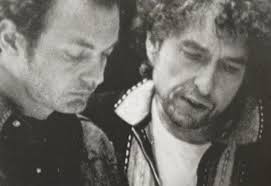
DYLAN AND LANOIS
In the songs of Dylan’s later career, beginning with 1997’s Time Out of Mind (also produced by Lanois), he often uses what appear to be complaints about lovers as a way of dealing with his own relationship with his artistic muse, or source of inspiration. Most of The Time (which has many similarities to the highly ironic Love Sick from the later album) uses the address to the ‘woman’ who has supposedly deserted him as a cipher for the way his inspiration has failed him in recent years. Through most of his career, Dylan has not been a ‘steady worker’ like his contemporaries Paul Simon, Leonard Cohen or Joni Mitchell, who tend to polish and refine their songs to ‘perfection’. In contrast, with his grounding in the philosophy of the Beat poets, the Romantics and the French symbolists, Dylan has always relied on spontaneity and flashes of inspiration. At times, however, the ‘visions’ that he has relied on have failed to magically appear. This was especially true in his post-conversion songs of the 1980s. But it would take him some years before he could fully recover his relationship with his muse.

What Was it You Wanted and What Good Am I are more explicit developments of a similar theme. Both songs consist almost entirely of rhetorical questions. Both are directed towards lovers who have deserted him. But again we learn nothing about the character of these women, or any details of the supposed relationships. The focus of both songs is on the narrator himself. Rather than employing irony, Dylan uses the ‘abandoned lover’ persona to look deeply into his own soul. What Was it You Wanted begins with a distant sounding acoustic guitar and muffled hand drums before the insistent, nagging rhythm that will continue throughout the song comes in. This is embellished by subtle touches of distant-sounding guitar. The music is restrained throughout, with no dramatic upsurges. From the outset Dylan sounds pained, world weary and resigned to his fate. Each of the five eight line verses and two bridges contains two or more rhetorical questions, which he poses in a half spoken, half whispered tone. The narrator surely knows that no answers will be given.

The opening lines: … What was it you wanted?/ Tell me again so I’ll know/ What’s happening in there?/ What’s going on in your show?…are so prosaic that they immediately give a sense of someone who is searching for but not quite finding the words he really wants to use. Already he sounds beaten, defeated. In the second half of the verse he asks the subject of the song the same question, remarking with studied casualness that …I’ll be back in a minute… as if he has somehow been delayed by some trivial matter before telling her, in a pointedly informal way that …You can get it together by then… But we already know that she will not ‘get it together’ to provide him with an explanation as to why she has left him so bereft. He then carries on trying to be persuasive: …We can start it all over/ Get it back on the track… All this, however, will be in vain. He then addresses her quite directly …You got my attention / Go ahead, speak… but we get the distinct impression that she is not actually there to listen to him, as if he is directing the question to a mirror. As with Most of the Time, the emotional power of the song is derived more from what is not said than what is actually being said.

This line is followed by the rather ominous …When you were kissing my cheek…. which may be an indication that all she has been able to offer him in terms of intimacy is this non-sexual gesture. But the phrase, with its rather obvious connotations of the ‘Judas kiss’, suggests that the narrator feels that her rejection of him can be considered to be a betrayal. Those familiar with Dylan’s history will be aware that, at the climax of his legendary 1966 show in Manchester, he was accused by a member of the audience of being a ‘Judas’ who had betrayed his ‘faith’ in folk music. In the penultimate verse of With God on Our Side, his polemic about the misplaced use of religion to justify war and genocide, he had posed another rhetorical, and perhaps unanswerable, question as to whether Judas had ‘God on his side’ when he sold Jesus out to the Romans.

In the following verse he pointedly buids on this reference. The narrator adopts a faux-naïve attitude which now seems to be heading in a rather paranoid direction …Was there somebody looking/ When you gave me that kiss?/ Someone there in the shadows/ Someone that I might have missed?… He refers continually here to the absence of the lover and his lack of understanding of her desires: …Is there something you needed/ Something I don’t understand… The repetition of these similar sounding words indicates that, in his mind, the same questions are being repeated without any resolution. He seems to be implying that he has been betrayed – by a lover or perhaps by his audience. But the final, highly ominous, lines of the verse: …What was it you wanted/ Do I have it here in my hand?… may indicate that he feels he has actually betrayed himself.

The second half of the song provides a little more musical variation, with two bridges positioned after the third and fourth verses. In the first bridge the narrator begins to question the reality of the whole situation and to examine the veracity of his own memory. He appears to assert that he knew the answer to the main question he has been asking, but has now forgotten it: …Whatever you wanted/ Slipped out of my mind/ Would you remind me again/ If you’d be so kind… The final line sounds excessively polite, making the narrator sound either weak or cynical, depending on the delivery. But Dylan gives nothing away here, maintaining his emotionally neutral tone. We then get the nearest the song comes to a metaphor: …Has the record been breaking/ Did the needle just skip?… which appears to be a self referential reference to the recording itself. The expression ‘a broken record’ is often applied to a person who continually ‘bangs on’ with the same repetitive questions, which the narrator clearly does here. But he then gives us another reference to the ‘Judas kiss’: …Is there somebody waiting/ Was there a slip of the lip?… But of course she is not there to respond.

The narrator then asserts that he cannot remember what she was demanding of him. He even asks …Are you the same person/ That was here before….It seems that his own grip on reality is ‘slipping’ …Is it something important… he asks. For the first time he gives us an answer, although a very equivocal one. …Maybe not… he mutters. An instrumental break follows, with some wispy snatches of harmonica which seem to illustrate his half hearted emotional commitment. In the second bridge he wonders: …Whatever you wanted/ What could it be?/ Did somebody tell you/ That you could get it from me?… He then again questions the reality of the whole exchange…Why do you want it?/ Who are you anyway…

If this is really a lover, she is a very indistinct one. In the final verse the narrator appears to be disorientated as the entire scenario seems to collapse: … Is the scenery changing?… he asks …Am I getting it wrong?… Then he suggests that he will always be stuck asking these futile questions…Is the whole thing going backwards?… he wonders, rather dreamily …Are they playing our song?…. thus referring both to the romantic cliché of lovers having a song that they share which will affirm their love. At the same time this appears to be another reference to the fact that this is all being expressed in a supposedly ‘romantic’ ballad. The notion of ‘playing a song’ together often implies that the participants are in some kind of harmony or agreement and are ‘singing from the same hymn sheet’. The final questions hand in the air: …Where were you when it started?/ Do you want it for free?/ What was it you wanted/ Are you talking to me?… with the final line echoing Robert De Niro’s iconic catch phrase in the role of Travis Bickle in Martin Scorsese’s classic political/psychological thriller Taxi Driver. In the movie the line indicates that Bickle is taking unashamed responsibility for the attempted murder of a corrupt politician. Here Dylan uses the line to further question the reality of the entire scenario.
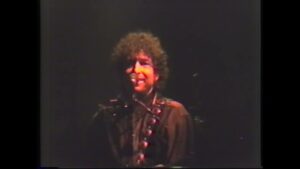
If What Was it You Wanted can be seen as a coded deconstruction of the notion of a romantic song, used as a piece of withering self-examination by a poet who had been suffering from a severe lack of inspiration, What Good Am I is a more direct investigation of the narrator’s self worth. The tone of the lyrics and music are similarly restrained, but the lyrics are more clearly confessional and emotional. The musical setting on the album is even more minimal, with Lanois restricting the backing to quiet and restrained washes of organ and guitar, with many dramatic pauses. Here, however, Dylan – though still half-speaking in places, projects the emotional qualities of the song with a truly soulful and judiciously restrained vocal. As with What Was it You Wanted the song is highly enigmatic and mysterious, with the music again functioning as a constant, and relatively unchanging, backdrop.. In What Good Am I the supposed relationship being discussed is even more nebulous.
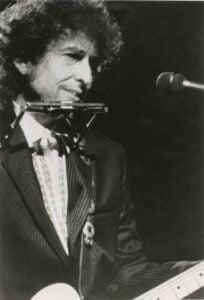
What Good Am I again uses simple language, with its rare metaphorical excursions being all the more powerful as a result of this. As with Most of the Time and What Was it You Wanted there is continual repetition of the title phrase. But there is precious little irony in the lyrics or the way Dylan delivers them. The song has five verses, four of which begin and end with the title phrase. This is a song about emotional and spiritual responsibility, in which the narrator asks searching questions about his own self worth. In Don’t Fall Apart From Me Tonight from 1983’s Infidels Dylan had mused: …I wish that I’d been a doctor/ Maybe I’d have saved some life that had been lost /Maybe I’d have done some good in the world/ ‘Stead of burning every bridge I crossed… Here, however, he asks a similar question with much greater subtlety. As with Most of the Time, much of the effect of the song is achieved by what it leaves out, rather than what it actually says.

The subject of What Good Am I is clearly in considerable distress. It may even be that the whole song is addressed not to a lover but to the victim of some disaster, like a war or a similar cataclysm, or even a fatal accident or disease. Perhaps Dylan is staring at the News on his TV and posing the difficult moral question that those in the privileged West often ask themselves. Can they just stand by and merely observe what happens in situations like this? The lyrics, however, are so minimal that any – or even all – of these interpretations can be considered valid.
The song opens with the question …What good am I if I’m like all the rest… followed by …If I just turn away, when I see how you’re dressed/ If I shut myself off so I can’t hear you cry… The language is simple, clear and direct. This makes the song’s one real metaphorical line …
If I turn a deaf ear to the thunderin’ sky… especially prescient. While the first verse had suggested the subject of the song as some kind of disadvantaged victim, here there is a clearer indication that she was his lover … What good am I while you softly weep/ And I hear in my head what you say in your sleep… This is not, however, the narrator overhearing what his lover says in her sleep but him imagining it. The lines are followed by the deathless …And I freeze in the moment like the rest who don’t try… perhaps the song’s most scarily self deprecating statement.
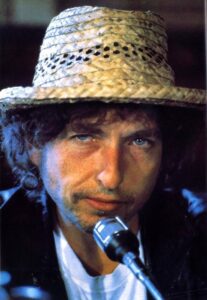
In the final verses the self-examination becomes explicit. The narrator asks …What good am I then to others and me/ If I’ve had every chance and yet still fail to see… He ponders as to the reasons for his inactivity: …If my hands are tied must I not wonder within/ Who tied them and why and where must I have been?… He appears to admit that he is incapable of taking responsibility or truly engaging with other people: …What good am I if I say foolish things/ And I laugh in the face of what sorrow brings… The final devastating lines …And I just turn my back while you silently die/ What good am I?… are harrowing, if perhaps ambiguous. Is the narrator referring to the ‘death’ of a relationship, of his lover’s self confidence or a real death? In this case, perhaps all of these interpretations are valid. What Good Am I, although it is deceptively simple in its lyrical and musical construction, is an extremely moving and powerful depiction of an individual emotional crisis. But if Dylan is questioning his own capabilities here, he shows in this, and the other two songs, that he can turn the simplest of language into profound poetry.
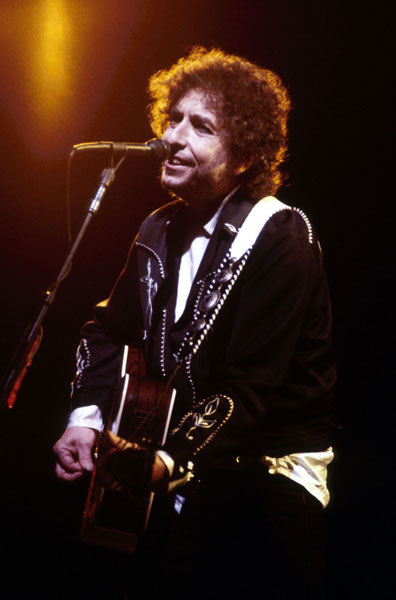



Leave a Reply